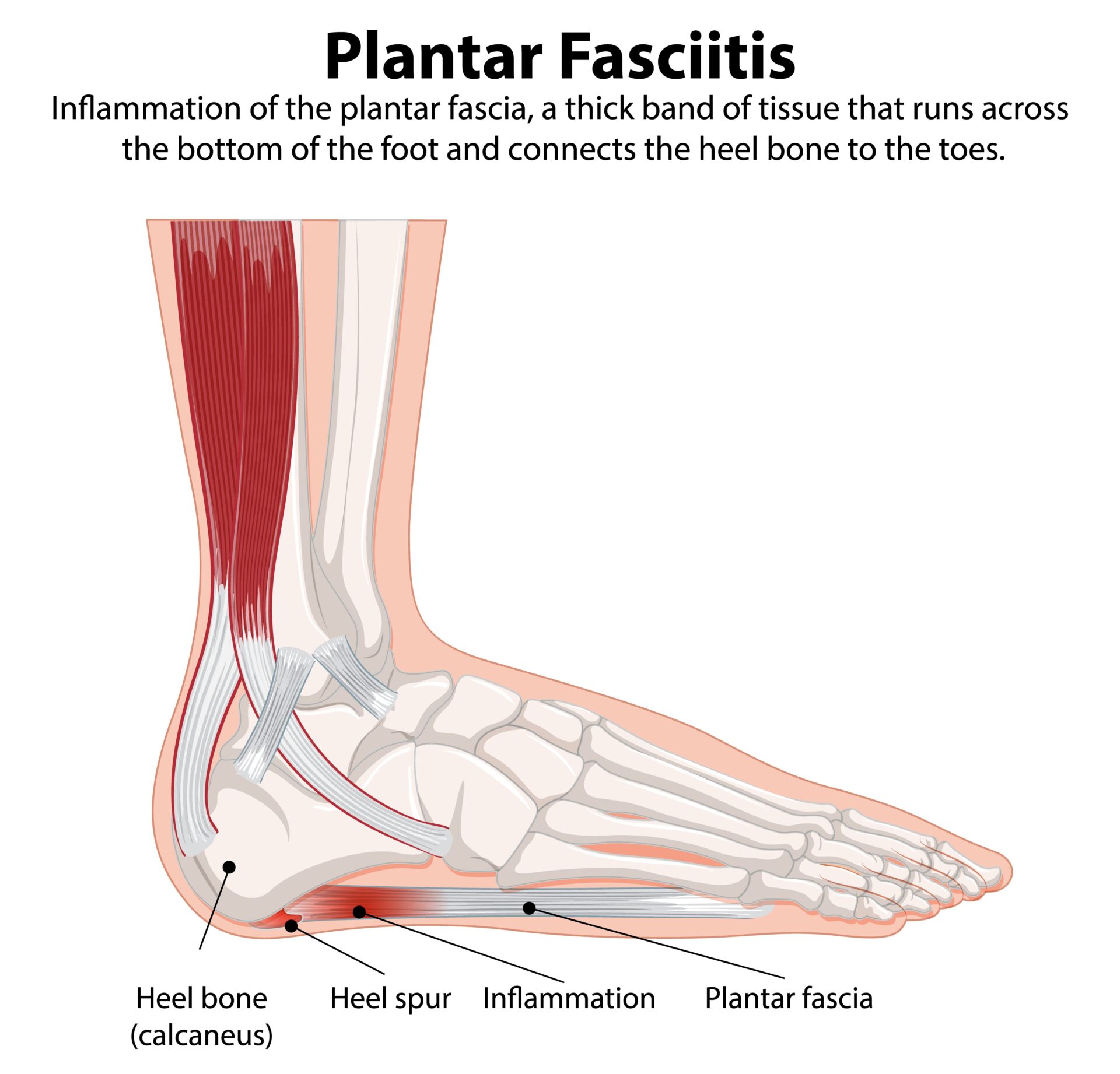
22 Aug How to Treat Plantar Fasciitis (Home Remedies, Surgery, Exercise)
How to Treat Plantar Fasciitis (Home Remedies, Surgery, Exercise)
By Island Hospital | August 22, 2025 10:34:09 AM
Plantar fasciitis is one of the most common causes of heel pain, especially among runners, people with flat feet, or those who spend long hours standing.
It can feel like a stabbing pain in your foot that starts your day off on the wrong foot—literally. Fortunately, this condition is treatable with conservative care in most cases.
In this article, we go in-depth into the treatment for plantar fasciitis, covering the treatment methods, surgery aftercare, exercise, pain management, and much more!
What is Plantar Fasciitis?
Plantar fasciitis is a painful foot injury that is caused by repetitive strain to the plantar fascia. The symptoms of this condition include:
- A stabbing pain in your heel when you first step out of bed in the morning or after sitting or lying down for a long time.
- Worsening pain at the end of the day or after spending long periods on your feet.
Plantar fasciitis is caused by several factors, such as constant stress to the feet, being overweight, tightness of Achilles tendon, increase in activity level, unsuitable footwear, rheumatic conditions, and high arched or flat feet.
Note: Heel spurs do not cause plantar fasciitis, although you can have both conditions at the same time.
Learn how to differentiate sprain vs. strains in this article, which compares the symptoms, diagnosis, treatment, causes, and much more!

Photo by Freepik
Treatment For Plantar Fasciitis
Plantar Fasciitis can usually be treated at home. Recovery may take anywhere between a few weeks to a few months. Surgery is typically a last resort treatment – 90% of people can recover with conservative treatment.
Home Remedies
Plantar fasciitis is initially treated at home with the RICE (rest, ice, compression, elevation) method and anti-inflammatories. Here are a few ways to manage and treat this condition:
- Over-the-counter NSAIDs: Medications like ibuprofen or naproxen can reduce pain and inflammation.
- Rest your foot: Avoid high-impact activities, especially running or standing for prolonged periods.
- Icing your foot: Apply an ice pack to your heel for 15-20 minutes several times a day.
- Wearing supportive shoes: Choose footwear with arch support and cushioning, and avoid walking barefoot on hard surfaces.
- Orthotics or shoe inserts: These can redistribute pressure and support the arch.
- Physical therapy: Simple stretches and massage techniques help to improve flexibility and strengthen the foot and calf muscles.
Clinical Treatments
Your healthcare provider may recommend the following treatments:
- Immobilisation: A walking boot or brace may be used to rest the foot and allow healing.
- Corticosteroids: Injected directly into the heel, these can offer short-term pain relief.
- Platelet rich plasma (PRP): A regenerative treatment using your own blood to promote healing.
- Extracorporeal pulse activation technology (EPAT): A non-invasive procedure using sound waves to stimulate tissue repair.
- Percutaneous needle tenotomy: Involves using a needle to stimulate blood flow and break up scar tissue in the fascia.
- Plantar fasciitis treatment:
- Gastrocnemius recession: Lengthening of the calf muscle to reduce tension.
- Plantar fascial release: Involves cutting part of the fascia to relieve tension and inflammation.
To understand your options, consult your healthcare provider. They may assess your condition with physical and imaging tests to determine the best course of treatment.
Life After Plantar Fasciitis Surgery
Surgery is typically considered when 6 to 12 months of conservative treatment fail to bring relief. While most patients find lasting improvement after surgery, the recovery journey can be gradual and requires commitment.
What to Expect After Surgery
Immediately after surgery, you’ll likely need to wear a walking boot or cast for 2 to 3 weeks to protect the surgical site. Crutches may be required for the first few days to avoid putting weight on the heel. Your doctor may also prescribe pain medication, icing, and elevation to manage post-op discomfort and swelling.
Once the incision has healed, physical therapy becomes an essential part of recovery. Therapy helps you regain strength and flexibility, retrain your gait, and gradually restore normal movement patterns. Patients typically begin with range-of-motion exercises, progressing to strengthening and balance work over time.
Some stiffness, mild swelling, or tingling may persist for several weeks. It’s crucial to follow your surgeon’s guidelines during this period, including avoiding barefoot walking and high-impact activity until cleared.
How Long is the Recovery Period?
The full recovery timeline ranges between 6 to 10 weeks for minor procedures like plantar fascial release. For more involved surgeries or if there are complications, recovery may stretch up to 3 to 6 months. Athletes and active individuals may take longer to return to high-intensity training.
Is Surgery Risky?
Like any surgical procedure, plantar fasciitis surgery carries some risks—but complications are rare. Common risks include:
- Infection at the incision site
- Nerve irritation or damage (numbness or tingling in the heel)
- Over-release of the plantar fascia, which may cause instability in the foot
- Scarring or lingering heel pain
That said, most patients report excellent outcomes, especially when they complete a supervised rehabilitation program and make necessary lifestyle adjustments.
Exercises For Plantar Fasciitis
Exercise plays a crucial role in both recovery and prevention. The goal is to reduce tension in the plantar fascia, Achilles tendon, and calf muscles.
Here are a few exercises to try:
| Exercise | How to Do It |
|---|---|
| Towel Stretch | Sit with legs extended, loop a towel around your foot and gently pull. |
| Calf Stretch | Start facing a wall, place one foot behind and press your heel down. |
| Towel Scrunches | Use your toes to scrunch a towel placed on the floor — this strengthens foot muscles. |
| Foot Rolling | Roll a frozen water bottle or tennis ball under your arch for massage. |
| Toe Extension Stretch | Cross one leg over the other and pull the toes back to stretch the arch. |
Perform these stretches daily, especially before getting out of bed and after physical activity.
How to Prevent Recurrence of Plantar Fasciitis
To reduce your risk of plantar fasciitis:
- Maintain a healthy weight to reduce pressure on your feet
- Wear shoes with good arch support and shock absorption
- Warm up properly before any activity, and cool down with stretches afterward
- Have enough rest between high-impact physical activities
- Avoid any activities that cause pain to your feet
- Gradually increase the intensity and duration of new workouts
Knee ligament tears are another common injury faced by athletes and active individuals. Learn all about management and treatment in our complete guide.
Get Back on Your Feet With Island Hospital
At Island Hospital, our Orthopaedic Specialists are dedicated to helping you regain full mobility. We offer personalised treatment plans, advanced rehabilitation services, innovative research & cutting-edge techniques, & comprehensive care for both adults and children.
Our renowned Orthopedicsand Spine Centre, recognised as one of the best in the country, provides expert treatment for a wide range of conditions, including spine injuries, arthritis, carpal tunnel syndrome, scoliosis, total knee & hip replacement, tendon, nerve, & vessel repair, and sports injuries.
Our commitment to excellence has earned us recognition as:
- the finalist for Malaysia’s Flagship Medical Tourism Hospital Programme,
- a place on Newsweek’s lists of World’s Best Hospitals 2025, and
- a place on Newsweek’s Best Specialised Hospitals Asia Pacific 2024 (Orthopaedic).
Don’t let an injury hold you back from living your best life – Schedule an appointment today to start your journey to recovery!
FAQ
Should I limit walking with plantar fasciitis?
It’s okay to walk short distances, but you should avoid long walks or standing for extended periods when symptoms are flaring. Wearing supportive shoes and resting when needed can help reduce strain on your plantar fascia.
Do I have to do my exercise programme forever?
Once your symptoms improve, you can reduce the frequency of your exercises, but continuing some form of stretching and strengthening can prevent recurrence. Think of it as long-term maintenance for your feet.
Is there a risk of injury to my plantar fascia while doing my exercises?
Yes, if exercises are done incorrectly or too aggressively, they can strain or aggravate the plantar fascia. Always follow your physiotherapist’s guidance and stop if you feel sharp or increasing pain.
How to sleep with plantar fasciitis?
Try sleeping with your feet in a neutral position rather than pointed downward, which can tighten the fascia overnight. Night splints or gentle calf stretches before bed may help reduce morning pain.
When can I go back to my sport?
You can gradually return to your sport once pain significantly reduces and you’ve regained flexibility and strength in your foot. A slow, structured reintroduction helps prevent injury.
How do I tell if plantar fasciitis is healing?
Healing is usually marked by less morning heel pain, reduced discomfort after activity, and improved foot flexibility. Consistency with treatment and exercises leads to steady, noticeable progress over time.
Take Charge of Your Health Today!

We’re offering our comprehensive Executive Health Screening Package at only RM760 – giving you a complete head-to-toe health assessment for peace of mind.
Our package features vital health screenings, including Cardiovascular Assessment, Full Blood Picture, Radiological Screening, Diabetes Screening, Kidney Function Test, and much more.
What’s Included in Your Screening Experience:
✔ Physical examination
✔ Complete medical report
✔ Consultation by Health Screening Physician/Specialist
✔ Choice of light refreshments
✔ Exclusive Island Hospital woven bag







